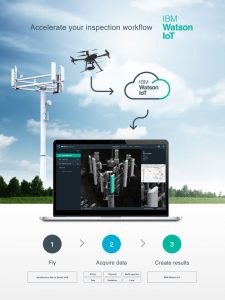
Inspection teams can deploy Aerialtronics drones from the ground and, through high-definition cameras and Watson Visual Recognition APIs, immediately gain a complete 360-degree, high-resolution overview.
IBM and Aerialtronics introduced the first commercial drones featuring cognitive computing capabilities from the IBM Watson Internet of Things (IoT) Platform on IBM Cloud. Aerialtronics vehicles provide inspection services for global organizations across multiple industries, from monitoring city traffic patterns to inspecting wind turbines, oil rigs and cell-tower optimization.
Aerialtronics’ commercial drones are the first to leverage the IBM Watson IoT Platform and the Visual Recognition APIs to analyze images and identify specific areas of concern such as loose or frayed cabling and damaged equipment that could impact the quality of telecommunications service to consumers. Constantly learning over time, IBM Watson IoT solutions provide a confidence rating to teams so they can determine if and when repairs should be made. As a result, businesses can increase the number of daily cell-tower inspections, reduce possible human error and help maintain the safety of workers.
“Pairing the unlimited perspective of drones with Watson IoT can bring these powerful cognitive capabilities to any location, where it can be used to analyze unexpected traffic patterns resulting from nearby construction or how a train is performing while it’s in transit,” said Harriet Green, general manager, IBM Watson Internet of Things, Commerce & Education.
